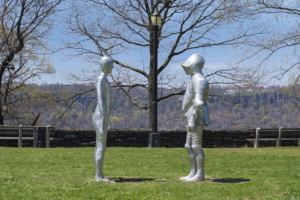
Steinunn Thorarinsdottir with a sculpture from her exhibition “ARMORS” at Fort Tryon Park. [Image: Sarah Cascone]
Thorarinsdottir first thought up the idea for her “ARMORS” installation five years ago, when she became fascinated with the arms and armor department in the Medieval Collection at the Met while on a long visit to New York.
At the opening reception for her Cloisters show, Thorarinsdottir said, “I started to think about how to incorporate armor into my figurative visual work.
“Two years ago, I thought, ‘I have to make it a reality because it’s stayed with me for so long.'”
A recurring motif in her work is androgynous figures, and she thought it would be a good idea for an project to place the solid, powerful armor next to “the vulnerability of the naked figure.”
In 2011, Thorarinsdottir was the subject of an exhibition with the New York City Department of Parks and Recreation across from the UN, and so this year approached the Art in the Parks program with her new idea, which was accepted with enthusiasm. Jennifer Hoppa, the Northern Manhattan Park Administrator, was the one who suggested Fort Tryon Park.Once Thorarinsdottir saw the site’s lush green lawn located beneath the Cloisters, a stunning piece of architecture built in the 1930s from multiple Gothic cathedrals shipped overseas from Europe stone by stone, she agreed that it was the perfect place.Hoppa explained, “We have an incredible Medieval collection here, so it was a good fit.”
The Met also quickly agreed to the project, and the curator, Donald La Rocca, even took Thorarinsdottir on a walk-through of the museum’s arms and armor display, directing her attention to the specific suits of armor that he thought would best fit the installation. Luckily, the three pieces he pointed out were the same ones that Thorarinsdottir has wanted to use since she first had the idea.
Thorarinsdottir collaborated with the Advanced Imaging Department at the Met to create the unique sculptures, first developing 3D scans of the chosen suits of armor. Old and new technologies alike were used – first, the three suits were 3D printed, then reproduced in cast aluminum using the lost wax method at a Chinese foundry.
There are many reasons for museums to take advantage of 3D printing and 3D scanning, like putting together 3D catalogs and sharing information with the masses, as well as creating unique new exhibits. The Met typically only scans artifacts as needed for the purposes of conservation, like making display mounts, and while it has no plans at the moment to scan all of the objects in its collection, it enjoyed the challenge of 3D scanning the suits of armor.
The General Manager of the Met’s Advanced Imaging Department, Scott Geffert, said, “This is fun because this is an artistic problem to solve. If you asked someone to scan armor they’d probably say no.”
Why did Geffert classify this as a problem? Because it’s difficult to accurately scan the many interlocking parts that make up an entire suit of armor.
Geffert explained, “If you were in a perfect world you could scan each piece and put it together, and you would have a lot more control.”
The imaging lab team kept the suits on mannequins, so if the armor jiggled even the slightest bit, the pieces would shift, meaning they would have to start all over again. But everything turned out just fine in the end.
“From a 3-D scan of high resolution, to a 3-D print to a wax mold to cast aluminum—that’s incredible to hold that level of detail. I was expecting something much more low-res with all those iterations,” Geffert said. “Technically, I’m very impressed.”
Each suit of armor sculpture faces one of Thorarinsdottir’s androgynous figures, which were cast using bandage molds from the body of her son – her model for over a decade. He posed the same way each of the three suits of armor did for the sculptural pairings.
Thorarinsdottir is very happy with the way that her public art installation turned out – especially how the suits of armor, made possible with 3D scanning, sparkle on the lawn.
- [Image: Azhar Kotadia]
- [Image: Sarah Cascone]
Thorarinsdottir said, “It’s totally different from behind the glass at the Metropolitan.”
You can see “Steinunn Thorarinsdottir: ARMORS” for yourself until September 12, 2018, at Fort Tryon Park in New York.
Discuss this and other 3D printing topics at 3DPrintBoard.com or share your thoughts below.
[Source: ArtNet News]
Subscribe to Our Email Newsletter
Stay up-to-date on all the latest news from the 3D printing industry and receive information and offers from third party vendors.
You May Also Like
Profiling a Construction 3D Printing Pioneer: US Army Corps of Engineers’ Megan Kreiger
The world of construction 3D printing is still so new that the true experts can probably be counted on two hands. Among them is Megan Kreiger, Portfolio Manager of Additive...
US Army Corps of Engineers Taps Lincoln Electric & Eaton for Largest 3D Printed US Civil Works Part
The Soo Locks sit on the US-Canadian border, enabling maritime travel between Lake Superior and Lake Huron, from which ships can reach the rest of the Great Lakes. Crafts carrying...
Construction 3D Printing CEO Reflects on Being Female in Construction
Natalie Wadley, CEO of ChangeMaker3D, could hear the words of her daughter sitting next to her resounding in her head. “Mum, MUM, you’ve won!” Wadley had just won the prestigious...
1Print to Commercialize 3D Printed Coastal Resilience Solutions
1Print, a company that specializes in deploying additive construction (AC) for infrastructure projects, has entered an agreement with the University of Miami (UM) to accelerate commercialization of the SEAHIVE shoreline...



































